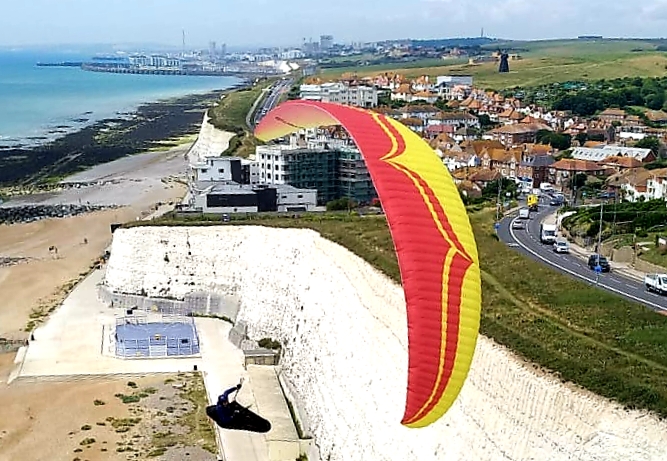Travelling home from Rye on Monday, I came across someone who I thought was a backpacker who had lost his way, but no the huge rucksack he was carrying contained a paraglider and the chap carrying it was David Willis.
He had just landed in a field having flown from Devil’s Dyke, near Brighton, and asked me where the nearest bus or train station was. To cut a long story short I took him and his huge rucksack to Rye in the Land Rover and as we got to the station, by chance a train bound for Eastbourne was just pulling in, which he ran for and caught.
It was a rush but there was time to make our brief introductions and I asked him if I could write about him and his amazing sport and David kindly agreed, wrote the following article and sent me the two photos which he took whilst airborne.
“People are often surprised at how far we can travel – the furthest any of our group got yesterday was Hythe (from Devil’s Dyke). Usually we try for Ashford because of the good trains back to Brighton, but on an exceptional day Margate is the ultimate goal – and you can’t go any further! Yesterday, another friend of mine flew 214 km from the Malverns to Sudbury in Norfolk, and it was a ‘declared goal’ – meaning that he set out to get out to Sudbury, which gets more points in the cross-country league that many paragliders compete in over the year.

“By the way, we fly paragliders, rather than hang gliders. Paragliders are less efficient with about a 10-to-1 glide ratio, compared with double that for hang gliders. And sail planes (unpowered aeroplanes) have an amazing glide ratio of 50 or 60 to 1. But the beauty of paragliders is that they need very little space to take off and land, and pack up quickly into a rucksack which can be easily (ish!) carried – weighing about 15kg.
“In still air, paragliders travel at about 15mph. So they travel much more quickly going with the wind (down-wind). In a 15mph wind they travel at 30mph down-wind, but are at a standstill going into wind. So on a typical flying day at Devil’s Dyke the wind will be north-west for take off, and then veer west. So the direction we travel is with the wind to the east, taking us over Lewes, then towards Heathfield or Hailsham, and then over the Weald hopefully in the Ashford direction. But of course if we can’t find rising air (thermal updrafts), then we have to land – hopefully close to civilisation!
“As members of the British Hang Gliding and Paragliding Association we have third party insurance cover – meaning that if we cause any damage to crops, livestock, buildings etc. then we are fully insured. It’s very rare that this happens and most landowners are extremely helpful – but you do get the occasional angry farmer! if you do land in a field then it’s often a case of walking to the nearest bus or train, with the aforementioned rucksack – where as you know a lift is very much appreciated!”
Editor’s note: This was a brief encounter and I think it’s the first time Rye News has ever featured paragliding but hopefully, thanks to David it may become a regular feature.
Image Credits: David Willis , David Willis .



